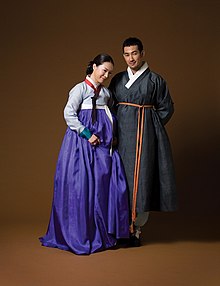Breast binding
"[5] Korean women wearing the traditional hanbok concealed the female body by binding their breasts tightly with a cloth band.
[citation needed] In Africa, adolescent Wodaabe girls had their breasts tightly bound to induce sagging, minimize sexual desirability, and improve their ability to breastfeed.
[10] Until the early 20th century, many Catholic nuns bound their breasts under their habit to deflect the attention of male clergy and diminish sexual desire in men.
[11] Post-WWI women office workers modified their physique with bound breasts to reduce and conceal the female form, thereby minimizing sexual curiosity from males.
[21] In case of health concerns, they tend to seek help from healthcare professionals they perceive as trans-friendly and who will not stigmatize their binding practice.
[14] Some apparel companies (such as Underworks) make compression shirts for cisgender men that provide the same result as a breast binder.
Breast binding is known to create a number of health risks, including difficulty breathing, backache, skin rashes, and deformity of the ribs.
[21] Binding for extended periods of time can lead to rashes or yeast infections under the breasts,[25][26] back or chest pain, shortness of breath, overheating, or, rarely, fractured ribs.




